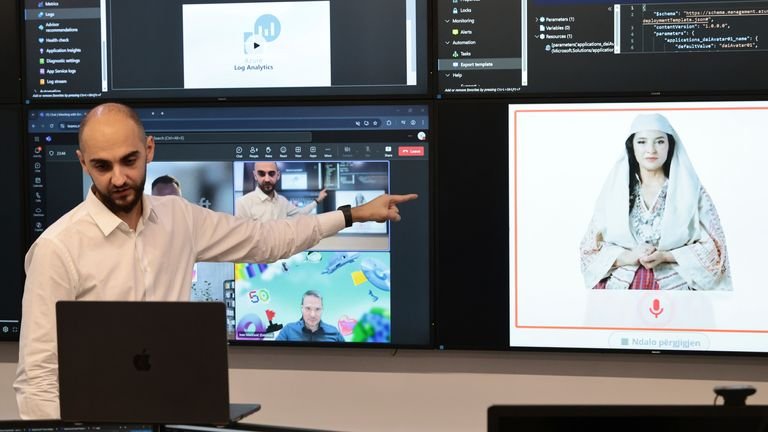First Person is where Chalkbeat features personal essays by educators, students, parents, and others thinking and writing about public education.
AI Insights
The limits of AI in the classroom

I was conferencing with a group of students when I heard the excitement building across my third grade classroom. A boy at the back table had been working on his catapult project for over an hour through our science lesson, into recess, and now during personalized learning time. I watched him adjust the wooden arm for what felt like the 20th time, measure another launch distance, and scribble numbers on his increasingly messy data sheet.
“The longer arm launches farther!” he announced to no one in particular, his voice carrying the matter-of-fact tone of someone who had just uncovered a truth about the universe. I felt that familiar teacher thrill, not because I had successfully delivered a physics lesson, but because I hadn’t taught him anything at all.

Last year, all of my students chose a topic they wanted to explore and pursued a personal learning project about it. This particular student had discovered the relationship between lever arm length and projectile distance entirely through his own experiments, which involved mathematics, physics, history, and data visualization.
Other students drifted over to try his longer-armed design, and soon, a cluster of 8-year-olds were debating trajectory angles and comparing medieval siege engines to ancient Chinese catapults.
They were doing exactly what I dream of as an educator: learning because they wanted to know, not because they had to perform.
Then, just recently, I read about the American Federation of Teachers’ new $23 million partnership with Microsoft, OpenAI, and Anthropic to train educators how to use AI “wisely, safely and ethically.” The training sessions would teach them how to generate lesson plans and “microwave” routine communications with artificial intelligence.
My heart sank.
As an elementary teacher who also conducts independent research on the intersection of AI and education, and writes the ‘Algorithmic Mind’ column about it for Psychology Today, I live in the uncomfortable space between what technology promises and what children actually need. Yes, I use AI, but only for administrative work like drafting parent newsletters, organizing student data, and filling out required curriculum planning documents. It saves me hours on repetitive tasks that have nothing to do with teaching.
I’m all for showing educators how to use AI to cut down on rote work. But I fear the AFT’s $23 million initiative isn’t about administrative efficiency. According to their press release, they’re training teachers to use AI for “instructional planning” and as a “thought partner” for teaching decisions. One featured teacher describes using AI tools to help her communicate “in the right voice” when she’s burned out. Another says AI can assist with “late-night lesson planning.”
That sounds more like outsourcing the foundational work of teaching.
Watching my student discover physics principles through intrinsic curiosity reminded me why this matters so much. When we start relying on AI to plan our lessons and find our teaching voice, we’re replacing human judgment with algorithmic thinking at the very moment students need us most. We’re prioritizing the product of teaching over the process of learning.
Most teachers I talk to share similar concerns about AI. They focus on cheating and plagiarism. They worry about students outsourcing their thinking and how to assess learning when they can’t tell if students actually understand anything. The uncomfortable truth is that students have always found ways to avoid genuine thinking when we value products over process. I used SparkNotes. Others used Google. Now, students use ChatGPT.
The problem is not technology; it’s that we continue prioritizing finished products over messy learning processes. And as long as education rewards predetermined answers over curiosity, students will find shortcuts.
That’s why teachers need professional development that moves in the opposite direction. They need PD that helps them facilitate genuine inquiry and human connection; foster classrooms where confusion is valued as a precursor to understanding; and develop in students an intrinsic motivation.
The problem is not technology; it’s that we continue prioritizing finished products over messy learning processes.
When I think about that boy measuring launch distances with handmade tools, I realize he was demonstrating the distinctly human capacity to ask questions that only he wanted to address. He didn’t need me to structure his investigation or discovery. He needed the freedom to explore, materials to experiment with, and time to pursue his curiosity wherever it led.
The learning happened not because I efficiently delivered content, but because I stepped back and trusted his natural drive to understand.
Children don’t need teachers who can generate lesson plans faster or give AI-generated feedback, but educators who can inspire questions, model intellectual courage, and create communities where wonder thrives and real-world problems are solved.
The future belongs to those who can combine computational tools with human wisdom, ethics, and creativity. But this requires us to maintain the cognitive independence to guide AI systems rather than becoming dependent on them.
Every time I watch my students make unexpected connections, I’m reminded that the most important learning happens in the spaces between subjects, in the questions that emerge from genuine curiosity, in the collaborative thinking that builds knowledge through relationships. We can’t microwave that. And we shouldn’t try.
Timothy Cook, M.Ed., teaches third grade and researches AI’s impact on education. He writes about cognitive development and technology at Psychology Today.
AI Insights
5 Top Artificial Intelligence Stocks to Buy in September

The opportunity in AI remains massive.
Artificial intelligence (AI) has been the driving force behind the stock market’s biggest winners in recent years, and that trend looks far from finished. The opportunity ahead is still massive, so this is an area that most investors will want some exposure to.
Here are five top AI stocks to buy as September rolls on.
Image source: Getty Images
1. Nvidia
No company has benefited more from the buildout of AI infrastructure than Nvidia (NVDA 0.43%). Its graphics processing units (GPUs) remain the gold standard for powering the training of large language models (LLMs), and its popular CUDA software platform helped give it a moat that competitors have yet to crack. Meanwhile, its networking revenue is also soaring, with demand for its NVLink, InfiniBand, and Spectrum-X products leading to a 98% year-over-year surge in Q2 data center networking revenue to $7.3 billion.
While its Blackwell chips are already the leading hardware for providing processing power for training, Nvidia said that those GPUs also set the standard for inference, which could eventually become a much bigger market than training. With AI infrastructure projected to be a multitrillion-dollar market in the coming years, Nvidia has more than enough room to keep growing.
The stock has had a massive run, but the momentum behind AI spending means Nvidia remains a top pick for long-term investors.
2. Broadcom
Broadcom (AVGO 0.19%) has emerged as the go-to name for custom AI chips, which are becoming critical as hyperscalers (operators of massive data centers) look to lower their inference costs and reduce their reliance on Nvidia. Broadcom already counts Alphabet (GOOGL 0.22%) (GOOG 0.27%), Meta Platforms (META 0.70%), and ByteDance among its customers, and management projects that these relationships alone could be worth $60 billion to $90 billion by its fiscal 2027 (which ends October 2027).
However, things got even better for shareholders after Broadcom revealed that a fourth customer, presumably OpenAI, had placed a massive $10 billion order for next year. The pace at which Broadcom is able to design custom AI chips appears to be accelerating, which bodes well for its growth, especially with Apple having been earlier revealed as a fifth major customer.
Throw in Broadcom’s strong networking business and its VMware arm, which positions it as a software player in AI infrastructure, and this is a company with a lot of growth potential. Investors looking for diversified AI winners beyond Nvidia should have this stock near the top of their lists.
3. Advanced Micro Devices
The next battleground in the AI chip wars looks like it will be for inference. While Nvidia and Broadcom are both well positioned for this fight, don’t count Advanced Micro Devices (AMD 1.91%) out. AMD has already been carving out a role in this space. Seven of the 10 biggest AI operators already use its GPUs, with one major AI company running a significant amount of inference on AMD chips.
AMD, along with Broadcom and others, also helped form the UALink Consortium to create an open-source interconnect standard. This could loosen the grip that Nvidia has established on that score with its NVLink offering, and allow companies to more easily mix and match AI chips from different vendors. That would be hugely beneficial for AMD.
On top of that, AMD’s central processing units (CPUs) continue to gain traction in data centers. The revenue gap between Nvidia and AMD is still massive, which is why even modest market share gains in the GPU segment could drive AMD’s numbers significantly higher. That opportunity makes the stock a compelling buy.
4. Alphabet
Alphabet just dodged what could have been a big problem when the judge in its antitrust case opted not to require it to sell its Chrome browser. That preserved one of the company’s most important advantages in search: distribution. That foundation, with Chrome and Android, gives Google an advantage that will be difficult for AI upstarts to overcome.
The company is now layering AI on top of search. Its AI Overviews are already being used by more than 2 billion people each month, and it’s rolling out AI Mode around the world in different languages. Meanwhile, its Gemini large-language models are among the best in the industry, and giving users the option to toggle between AI Mode and traditional search inside Google is another edge. Importantly, Alphabet knows how to monetize users, whether through traditional search or AI.
Beyond search, Google Cloud has been a powerful growth engine for Alphabet as companies rush to cloud computing providers to help build out their own AI models and apps and run them on cloud infrastructure. Meanwhile, its custom chips — made with the help of Broadcom — have given it a cost advantage. Add in other bets like its Waymo robotaxi business and its quantum computing efforts, and Alphabet is well-positioned for the future.
5. Meta Platforms
Meta Platforms has reinvented itself with AI, turning what many thought was a fading social media company into one of the best growth stories out there. Its Llama models are improving user experiences by serving up more engaging content, while advertisers get access to better targeting and ad campaign tools. That combination led to a 22% year-over-year jump in ad revenue last quarter, with both impressions and ad prices moving higher. Meta is also just starting to run ads on WhatsApp and Threads, opening up new growth avenues.
Yet CEO Mark Zuckerberg’s ambitions go well beyond ads. He has talked openly about building “personal superintelligence” and has been recruiting aggressively to make it happen.
With its huge operating cash flow, Meta can afford to chase big opportunities in AI, and it already benefits from AI-driven gains in its core business. That makes Meta an AI stock to own.
Geoffrey Seiler has positions in Alphabet. The Motley Fool has positions in and recommends Advanced Micro Devices, Alphabet, Apple, Meta Platforms, and Nvidia. The Motley Fool recommends Broadcom. The Motley Fool has a disclosure policy.
AI Insights
Albania’s prime minister appoints an AI-generated ‘minister’ to tackle corruption | World News

Albania’s prime minister has appointed an artificial intelligence-generated “minister” to tackle corruption and promote innovation in his new cabinet.
The new AI minister, officially named Diella – the female form of the word for sun in the Albanian language – was appointed on Friday and is a virtual entity.
Diella will be a “member of the cabinet who is not present physically but has been created virtually,” Prime Minister Edi Rama said in a post on Facebook.
Mr Rama said the AI-generated bot would help ensure that “public tenders are completely free of corruption” and assist the government in operating more efficiently and transparently.
Diella uses the latest AI models and methods to ensure accuracy in carrying out its assigned responsibilities, according to the website of Albania’s National Agency for Information Society.
Diella, portrayed wearing a traditional Albanian folk costume, was developed earlier this year in partnership with Microsoft. She serves as a virtual assistant on the e-Albania public service platform, helping users navigate the site and access around one million digital inquiries and documents.
Mr Rama’s Socialist Party won a fourth straight term by securing 83 out of 140 seats in the parliamentary elections in May.
With this majority, the party can govern independently and pass most laws, though it falls short of the 93-seat threshold required to amend the Constitution.
The Socialists have pledged to secure European Union membership for Albania within five years, aiming to complete negotiations by 2027 – a claim met with scepticism by the Democratic opposition, who argue the country is not ready.
Read more from Sky News:
All we know about suspect in Charlie Kirk’s shooting
UK joins NATO operation to bolster Europe’s eastern flank
The Western Balkan country began full EU membership negotiations a year ago. The incoming government now faces key challenges, including tackling organized crime and long-standing corruption – issues that have persisted since the end of communist rule in 1990.
Diella is also expected to support local authorities in accelerating reforms and aligning with EU standards.
President Bajram Begaj has tasked Prime Minister Rama with forming the new government, a move analysts say grants him the authority to establish and implement the AI-powered assistant Diella.
AI Insights
Simple AI model matches dermatologist expertise in assessing squamous cell carcinoma

A simple AI model has been shown to perform on a par with experienced dermatologists when assessing the aggressiveness of a common form of skin cancer, squamous cell carcinoma. The research was headed by the University of Gothenburg.
Each year, more than 10,000 Swedes develop squamous cell carcinoma. This is the second most common form of skin cancer in Sweden, after basal cell carcinoma, and its prevalence is increasing rapidly. Squamous cell carcinoma often develops in the head and neck region and other areas exposed to the sun over many years.
“This type of cancer, which is a result of mutations of the most common cell type in the top layer of the skin, is strongly linked to accumulated UV radiation over time. It develops in sun-exposed areas, often on skin already showing signs of sun damage, with rough scaly patches, uneven pigmentation, and decreased elasticity,” says associate professor and dermatologist Sam Polesie, who led the study.
Squamous cell carcinoma diagnosis is often easy – the challenge lies in the preoperative assessment – determining how aggressively the tumor is growing to plan and prioritize surgery appropriately. If the tumor is more aggressive, the surgery needs to be scheduled promptly, with more adjacent tissue removed. For less aggressive tumors, narrower margins can be used, with simpler procedures sufficient in some cases.
Almost identical performance
In many countries, Sweden included, preoperative punch biopsies are not routinely performed for suspected squamous cell carcinoma. Surgery is instead carried out based solely on the clinical suspicion of a tumor, with the entire excised specimen sent for histopathological analysis. The fact that surgery is performed without a preoperative biopsy underscores the need for assessment alternatives that do not require tissue samples, such as image analysis using artificial intelligence (AI).
For the study, the researchers trained an AI system in image analysis using 1,829 clinical close-up images of confirmed squamous cell carcinoma. The AI model’s ability to distinguish three levels of tumor aggressiveness was then tested on 300 images and compared with the assessments of seven independent experienced dermatologists.
The results, published in the Journal of the American Academy of Dermatology International, show that the AI model performed almost identically to the team of medical experts. At the same time, agreement between individual dermatologist assessments was only moderate, underscoring the complexity of the task.
Two clinical features – ulcerated and flat skin surfaces – were found to be clearly associated with more aggressive tumor growth. Tumors exhibiting these characteristics were more than twice as likely to fall into one of the two higher levels of aggressiveness.
Healthcare needs should decide
The use of artificial intelligence in skin cancer care has attracted a great deal of interest in recent years, although according to Sam Polesie, so far it has had limited practical impact within healthcare. He emphasizes the importance of clearly defined application areas where research can create added value for Swedish healthcare.
We believe that one such application area could be the preoperative assessment of suspected skin cancers, where more nuanced conclusions can influence decisions. The model we’ve developed needs further refinement and testing, but the way forward is clear – AI should be integrated where it actually adds value to decision-making processes within healthcare.”
Sam Polesie, associate professor and dermatologist
Sam Polesie is an associate professor of dermatology and venereology at the University of Gothenburg and a practicing dermatologist at Sahlgrenska University Hospital. The images comprising the study data were taken within dermatological healthcare at the university hospital between 2015 and 2023.
Source:
Journal reference:
Liang, V., et al. (2025). Assessing differentiation in cutaneous squamous cell carcinoma: A machine learning approach. JAAD International. doi.org/10.1016/j.jdin.2025.07.004
-

 Business2 weeks ago
Business2 weeks agoThe Guardian view on Trump and the Fed: independence is no substitute for accountability | Editorial
-
Tools & Platforms1 month ago
Building Trust in Military AI Starts with Opening the Black Box – War on the Rocks
-

 Ethics & Policy2 months ago
Ethics & Policy2 months agoSDAIA Supports Saudi Arabia’s Leadership in Shaping Global AI Ethics, Policy, and Research – وكالة الأنباء السعودية
-

 Events & Conferences4 months ago
Events & Conferences4 months agoJourney to 1000 models: Scaling Instagram’s recommendation system
-

 Jobs & Careers2 months ago
Jobs & Careers2 months agoMumbai-based Perplexity Alternative Has 60k+ Users Without Funding
-

 Podcasts & Talks2 months ago
Podcasts & Talks2 months agoHappy 4th of July! 🎆 Made with Veo 3 in Gemini
-

 Education2 months ago
Education2 months agoMacron says UK and France have duty to tackle illegal migration ‘with humanity, solidarity and firmness’ – UK politics live | Politics
-

 Education2 months ago
Education2 months agoVEX Robotics launches AI-powered classroom robotics system
-

 Podcasts & Talks2 months ago
Podcasts & Talks2 months agoOpenAI 🤝 @teamganassi
-

 Funding & Business2 months ago
Funding & Business2 months agoKayak and Expedia race to build AI travel agents that turn social posts into itineraries





















